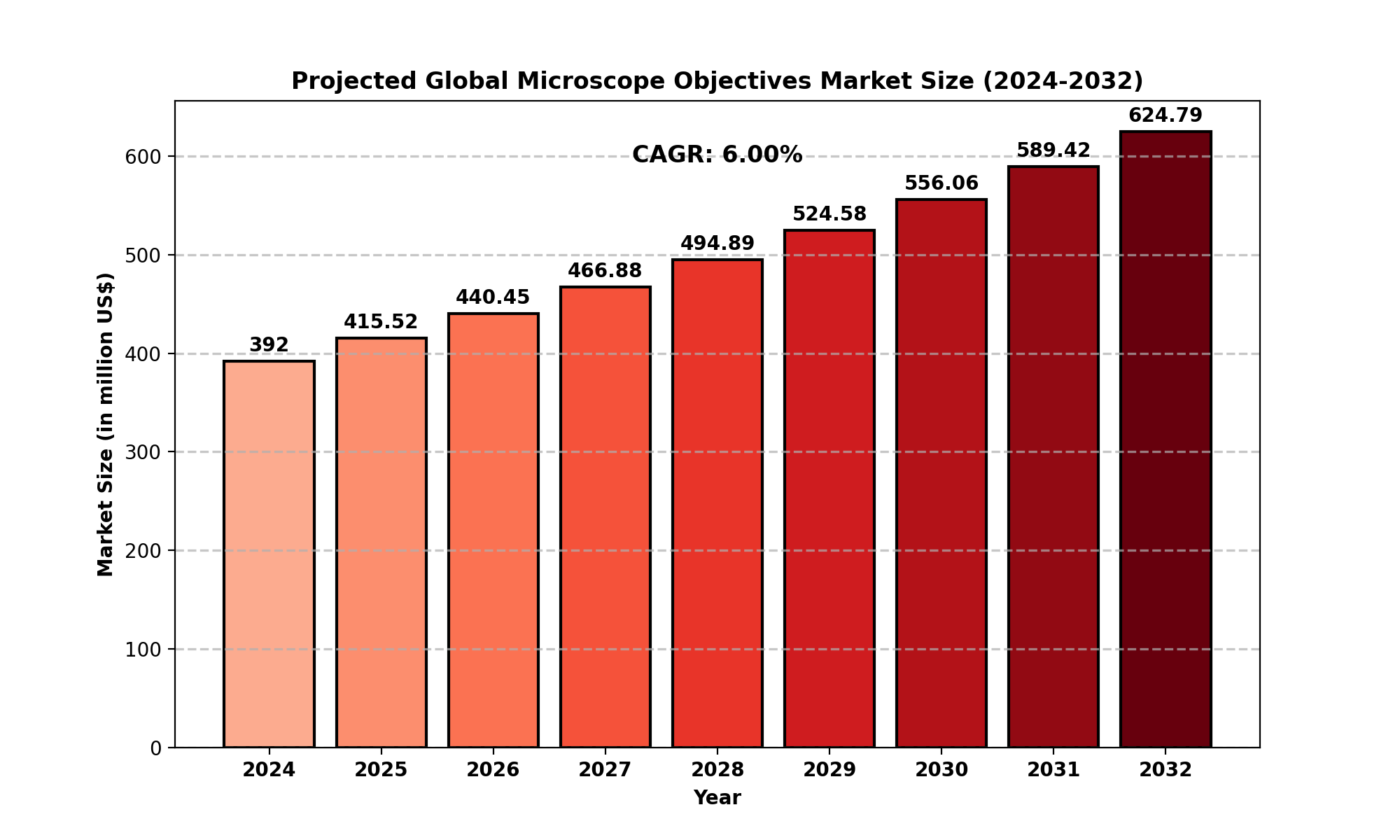TOP CATEGORY: Chemicals & Materials | Life Sciences | Banking & Finance | ICT Media

Download Report PDF Instantly
Report overview
Microscope objectives are crucial optical components in microscopes, responsible for magnifying and resolving specimen images. Typically mounted on a revolving nosepiece, these objectives allow users to switch between various magnification levels seamlessly. The performance of microscope objectives is influenced by several key characteristics, including:
Numerical Aperture (NA): Determines resolution and brightness.
Working Distance: The space between the lens and the specimen.
Resolution: The ability to distinguish fine details.
Field of View: The observable area of the specimen.
Aberration Correction: Minimizing optical distortions.
Market Overview
Market Size and Growth Projection
The global microscope objectives market was valued at approximately USD 392 million in 2023 and is projected to reach USD 624.7 million by 2030, exhibiting a Compound Annual Growth Rate (CAGR) of 6.0% during the forecast period.

Drivers
Increasing Demand for Microscopy in Research and Diagnostics: The growing application of microscopes in life sciences, material sciences, and industrial applications is fueling market growth.
Technological Advancements: Developments in imaging techniques, including fluorescence, super-resolution, and digital microscopy, are driving demand.
Rising Healthcare Expenditure: Increased government and private funding in medical research and diagnostics is expanding the market.
Growing Industrial Applications: Use in semiconductor inspections, nanotechnology, and metallurgy contributes to market expansion.
Restraints
High Costs of Advanced Microscope Objectives: Premium objectives with high numerical apertures and enhanced correction features are expensive.
Integration Challenges with Existing Systems: Advanced objectives often require upgrades in hardware and software, increasing overall costs.
Opportunities
Emerging Applications in Nanotechnology and Materials Science: Expanding research in nanomedicine, quantum physics, and material testing is creating new market opportunities.
Growing Adoption of Digital and AI-Powered Microscopy: AI-enhanced microscopy is improving image analysis and automation, boosting market demand.
Rising Demand in Developing Economies: Expanding research and healthcare infrastructure in China, India, and Brazil is accelerating market growth.
Challenges
Requirement for Skilled Professionals: Effective use of high-end objectives requires trained personnel, which can be a barrier in emerging markets.
Continuous Need for Innovation: Increasing competition necessitates constant technological advancements and high R&D investments.
By Application
Medical Centers: Hospitals, diagnostic laboratories, and pathology labs.
Research Centers: Academic institutions, government research agencies, and private R&D labs.
Industrial Applications: Semiconductor industry, forensic labs, and metallurgy.
By Type
Max 10x: Common for basic laboratory applications and educational use.
Max 50x: Used in research settings for moderate magnification needs.
Above 50x: High-resolution imaging for cellular, molecular, and material sciences.
North America
Market Leader: The U.S. dominates due to strong investments in biomedical research and semiconductor technology.
Key Players: Companies like Zeiss, Nikon, and Olympus have a strong presence.
Europe
Second-largest Market: Countries like Germany, the UK, and France drive innovation in optical technologies.
Government Funding: High R&D investments in biotechnology and healthcare boost demand.
Asia-Pacific
Fastest-growing Region: Countries like China, Japan, and India are witnessing increased adoption of advanced microscopy techniques.
Expanding Manufacturing Base: Rising investments in electronics, pharmaceuticals, and medical research.
South America
Moderate Growth: Growing awareness and investments in healthcare and forensic science contribute to market development.
Middle East and Africa
Emerging Market: Increasing demand for medical diagnostics and research but limited by economic constraints.
Key Companies
Olympus Corporation (Japan)
Nikon Corporation (Japan)
Carl Zeiss AG (Germany)
Leica Microsystems GmbH (Germany)
Newport Corporation (U.S.)
Thorlabs Inc. (U.S.)
Meiji Techno Co., Ltd. (Japan)
Mitutoyo Corporation (Japan)
Navitar Inc. (U.S.)
Motic Microscope (China)
Product Innovation: Companies are focusing on developing high-performance, AI-integrated, and digital microscopy solutions.
Strategic Partnerships: Collaborations with universities, research institutes, and medical centers for advanced research.
Geographic Expansion: Companies are expanding their presence in emerging markets through distribution networks and acquisitions.
Advancements in Super-Resolution Microscopy: Techniques like STORM (Stochastic Optical Reconstruction Microscopy) and PALM (Photoactivated Localization Microscopy) are enhancing imaging capabilities.
Integration of AI and Machine Learning: AI-driven image processing is revolutionizing research in cell biology and drug discovery.
Development of Multiphoton and Confocal Microscopy: Enhancements in laser scanning microscopy are improving 3D imaging.
Sustainable Manufacturing Practices: Increasing focus on eco-friendly production and recyclable optical components.
Expected Market Growth: The market is expected to expand steadily, driven by technological advancements and increasing research activities.
Opportunities in AI-Powered Microscopy: AI applications in microscopy will improve accuracy and efficiency in diagnostics and research.
Rising Investments in Personalized Medicine: Microscope objectives will play a critical role in genomic and molecular research.
Increased Automation in Microscopy: Automated solutions will enhance efficiency in industrial inspections and biomedical research.
What is the projected market size for the microscope objectives market by 2030?
Who are the major players in the microscope objectives market?
What are the key factors driving market growth?
Increased research and diagnostics applications.
Advances in digital and super-resolution microscopy.
Growing demand from healthcare and semiconductor industries.
Which region is expect****ed to witness the highest growth?